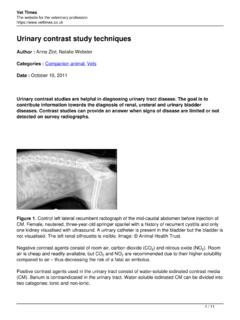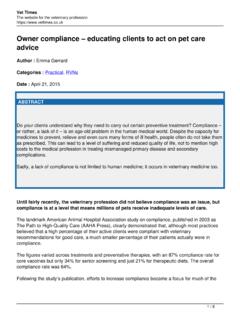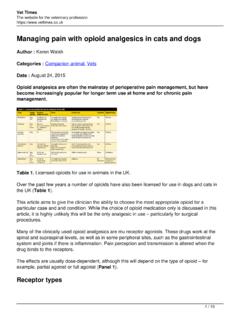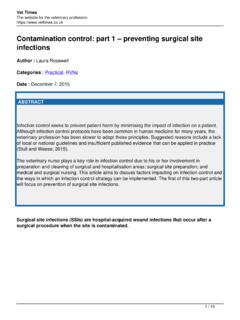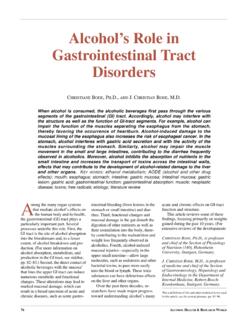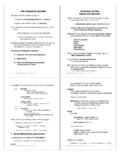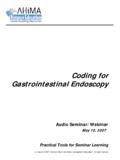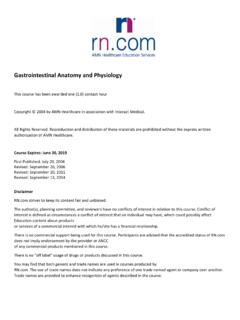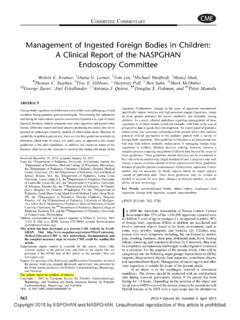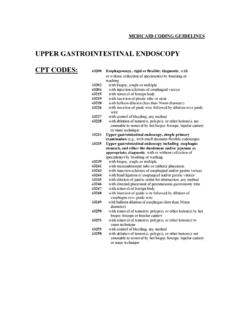Transcription of RABBIT NUTRITION – AN OVERVIEW - Vet Times
1 Vet TimesThe website for the veterinary NUTRITION AN OVERVIEWA uthor : Anna MeredithCategories : VetsDate : February 7, 2011 Anna Meredith discusses the importance feeding regimes have on pet RABBIT health, from thechoice of material to the introduction of new eating patterns FEEDING an appropriate diet to a RABBIT is probably the single most important factor inmaintaining its are now the third most popular mammalian domestic pet in the UK. They are also anextremely important livestock species and laboratory model great deal of literature relating to the nutrient requirements of production and laboratory rabbits isavailable, but relatively little relates specifically to pet rabbits have the potential for much longer lifespans than the short-lived production orexperimental RABBIT . Many of the diseases commonly seen in pet rabbits can be directly attributedto, or associated with, the feeding of an inappropriate diet and could be largely , manufacturers have responded to the need for good diets for pet rabbits, and in generalthe level of awareness of many of those involved with keeping pet rabbits has are hindgut fermenters, adapted to digest a high-fibre diet consisting mainly of grass.
2 Thegastrointestinal tract makes up between 10 and 20 per cent of bodyweight, and in relativeproportions, rabbits have the largest stomach and caecum of any monogastric animal. Gut transittime is rapid and eliminates fibre from the digestive tract as soon as possible, unlike other hindgutfermenters, such as horses (colon fermenter) and ruminants. 1 / 10 Gut retention in rabbits has been measured at about 17 hours, compared with 68 hours in cattle. Inthe wild, feeding takes place mainly in the early morning, evening and at night. Rabbits fed adlibitum have been shown to exhibit frequent feeding up to 30 Times a day, of 2g to 8g intake overfour to six considering the diet of a pet RABBIT , it is important to be aware of the dietary habits of wildrabbits. In terms of their teeth and digestive system, rabbits are adapted to eat a herbaceous dietthat is high in fibre, low in fat and low in starchy a natural setting, wild rabbits select the most tender, succulent plant parts that are most nutrient-dense.
3 They are referred to as concentrate selectors, allowing them to meet their dietaryrequirements in the minimum time above ground (when they are prone to predation). However, thenatural diet is not concentrated to the same degree as commercial diets, and is still naturally highin rabbits will eat a wide variety of foods, but generally show a preference for fibre and often eathay or straw rather than a concentrate ration. However, it can be difficult to persuade a RABBIT to eata new food item once it has become accustomed to a particular diet. Food preference is influencedby the mother s diet at kits raised by mothers fed different diets during pregnancy and lactation show a clearpreference for the diet of their mother at weaning (Bilko et al, 1994). It can be particularly difficult topersuade some rabbits to eat hay if they have not been introduced to it at an early age. In the wild,rabbits eat at dusk and dawn, and this is reflected in pet rabbits, which are most likely to eat in theearly evening or overnight and may not appear hungry during the other source of nutrients is the caecotrophs, which are packets of partially digested food,bacteria and bacterial products, including vitamins, eaten directly from the anus.
4 Cellulose,hemicellulose, pectin and lignin are mainly digested by the caecal bacteria, although a degree ofprecaecal digestion is thought to be achieved by pectinases and xylanases of microbial origin in thestomach and small intestine. Volatile fatty acids produced by the fermentative action of the caecalbacteria are absorbed across the caecal epithelium and used as an energy acid (60 to 80 per cent) butyric acid (eight to 20 per cent) and propriety acid (three to 10 percent) are produced, and proportions vary according to time of day, developmental stage of therabbit and diet. Butyric acid is the preferred substrate for colonocytes, and the liver is the mainorgan to metabolise propriety and butyric acid is available for extrahepatic tissue metabolism. It is estimated that the RABBIT obtains upto 40 per cent of its maintenance energy requirement from volatile fatty acids (VFA) produced bycaecal fermentation. 2 / 10 Caecotrophy is affected by energy and protein levels in the diet.
5 If the diet is energy deficient,rabbits will consume the total quantity of the produced caecotrophs. During ad libitum feeding,caecotroph intake depends on the protein and fibre content of the diet, being greater if the diet islower in protein or higher in fibre (Fekete, 1989). Fibre also has an important effect, both onappetite and caecotrophy. Low-fibre diets depress voluntary food intake (Bellier and Gidenne,1996) and diets high in fibre increase the RABBIT s appetite for caecotrophs (Fekete and Bokori,1985).Sweet foods are generally palatable, and molasses is used in some commercial foods to improvepalatability (Cheeke, 1994). Bitter tastes are also welltolerated, such as the saponins in alfalfa(Cheeke, 1987).Links between diet and diseaseLow-fibre and high-carbohydrate diets are linked to dental disease, gastrointestinal disease,obesity and behavioural problems. Excess calcium in the diet can be linked to sludgy urine andurolithiasis in some rabbits, and deficiencies in calcium can be linked to the progression of dentaldisease.
6 Dental diseaseRabbit teeth are aradicular hypsodont and grow constantly throughout rate of growth should balance the amount of wear produced by grinding fibrous foods, so thattooth length stays constant. Incisor wear, growth and eruption are, in a normal RABBIT , balanced at arate of about 3mm per week. Food is ground by lateral movements of the cheek natural diet of grass and plants, high in silicates, is highly abrasive to cheek teeth, so there israpid wear of around 3mm per month, with equally rapid tooth high-carbohydrate and lowfibre diet will lead to reduced tooth wear and, therefore, elongation ofthe tooth both above and below the gum. This results in irregular wear, distortion and the formationof sharp, painful spikes. Severe elongation of the cheek teeth can prevent the mouth from closingfully, which ultimately prevents the incisors meeting properly, causing them to also distorted teeth are predisposed to infection and the development of facial carbohydrate diets and reduced wear also predispose to vary on the significance of dietary calcium levels on dental disease.
7 Many rabbits areselective eaters of coarse mix, favouring items low in calcium and fibre. This can make them proneto osteoporosis, poor tooth and bone quality, and dental disease. Bone growth, development andmaintenance is also dependent on the mechanical stresses to which it is subjected. Rabbits that do 3 / 10not spend prolonged periods grinding fibrous food can also show poor jaw bone vitamin D levels are common in rabbits that have no access to sunlight, and this may also beassociated with poor tooth and bone quality. Although rabbits do not require vitamin D to absorbcalcium, low levels of calcium and vitamin D are likely to be a significant factor in the progression ofdental all dental disease is due to diet, and genetic factors are also important. A congenital maxillarybrachygnathism, particularly in extreme dwarf and lop breeds, can also be significant. gastrointestinal diseaseControlling gastrointestinal motility is is under the influence of the autonomic nervous system, prostaglandins and otherhormones, but is also largely stimulated and maintained by a high throughput of indigestible fibre(lignocellulose).
8 Motilin is a polypeptide hormone secreted by enterochromaffin cells of theduodenum and jejunum that stimulates gastrointestinal motility. Fat stimulates its release andcarbohydrate inhibits it (Brewer and Cruise, 1994).Fibre is thus critical to rabbits for gastrointestinal health because of its key role in stimulating andmaintaining normal gut motility. Low-fibre diets predispose to gastrointestinal (simple sugars and starches) are an important energy source and are digested andabsorbed in the stomach and small , any residual sugars or starch that are not digested and absorbed in the small intestinecan pass into the caecum as a substrate for bacterial fermentation. This results in a rapidovergrowth in potentially pathogenic caecal bacteria, such as Clostridium spiroforme, which canlead to enterotoxaemia and fatal diarrhoea. This is seen mainly in young, recently weaned rabbitswhen fed minimal hay and combined with the stress of a change of diet and a recent move, forexample from a breeder to a pet shop.
9 Behavioural problemsWild rabbits spend many hours a day eating. With regards to pet rabbits, low-fibre concentratediets are rapidly eaten and rabbits can develop vices related to boredom, such as increasedaggression or repetitive bar biting. Lack of fibre can also lead to fur chewing and barbering. ObesityFats are used in commercial RABBIT diets to improve palatability and provide a non-carbohydrate 4 / 10energy source. Fat also stimulates gastrointestinal motility, but reduces intestinal absorption treat foods contain high levels of fat (such as chocolate drops) and should not be fed. Highfat levels also increase the risk of hepatic lipidosis developing during periods of starvation. Petrabbits are prone to obesity, so high-fat diets and ad libitum feeding of concentrates should beavoided. UrolithiasisExcess calcium in the diet can contribute to sludgy urine or urolithiasis. Rabbits invariably have amuch higher serum calcium concentration than other mammals 30 to 50 per cent higher (Bussand Bordeau, 1984) due to their unusual calcium calcium concentrations reflect dietary intake, and fractional excretion i s around 44 per cent,compared to less than two per cent in most mammals.
10 Absorption from the gastrointestinal tract isnot believed to be under the control of vitamin D3. Parathyroid hormone (PTH) and calcitoninprotect rabbits from dangerous serum calcium is absorbed by both passive diffusion and active transport. Active transport does require acarrier protein synthesised in the intestinal mucosa in response to 1,25-dihydroxyvitamin absorption is very efficient, and vitamin D is not required for absorption if dietary levels areadequate. The kidney is important for preserving or excreting calcium, and is mediated by PTH andvitamin D3. Although it is normal for rabbits to have calcium carbonate crystals in urine, overweightinactive animals, those with neurological or other problems affecting normal bladder function andemptying, or those with urinary tract infections, seem predisposed to developing disease problemsassociated with the build up of excessive amounts of sludge in the , oxalates and acetates form complexes with calcium and other minerals, and this canhinder their absorption.
